By The Joining Vision and Action Team
It is true that these are unprecedented times. Yet for over three decades, JVA and its clients have partnered to ride out some difficult—at times almost unthinkable—moments in history.
JVA’s team has been considering the facets of our organization that have allowed us to keep moving forward steadily, even in difficult times, for 33 years. Three attributes that we believe show up in all of our work are innovation, equity and legacy.
In weeks past, we shared our thoughts on the meaning of innovation and equity in the time of COVID-19. Today, team members describe how “legacy” also helps to power our efforts.
Sharing and living up to a “legacy”
Conversations around justice in American society have necessarily grown louder and more urgent over the past several months, and it is clear that not every “legacy” is one to be proud of. Neither is every legacy of success or failure a reflection of merit.
When JVA speaks of our legacy, we are proud. As our website’s History section notes, one of our founding principles when Janine Vanderburg conceived of JVA was the idea that communities should be trusted to know what is best for them. Though we may not have used the same terminology 30 years ago, and though we have never been perfect, the quest for diversity, equity and inclusion was integral to JVA’s mission from the start.
We also know that our legacy is in no way ours alone. Each of our hundreds of clients and partners helped to construct it. Knowing this, we recognize that it is our duty to safeguard and fortify it—through actively learning, growing and striving to be our best.
With this in mind, we share our thoughts about JVA’s legacy.
1. What does “legacy” mean to you in relation to JVA?
Director of Operations Marshall Vanderburg: I believe an important element of creating a legacy is to act as an agent of positive societal change. For JVA, achieving the change is accomplished by facilitating client discussions tapping their service needs and desires, then using our knowledge and expertise to help grow the organizational capacity to better serve their constituencies.
JVA’s legacy of 30+ years providing various levels of capacity-building services have resulted in helping to grow strong and vibrant communities throughout greater Colorado.
Marshall: “Lasting legacy has community at its core.”
Another element of legacy involves creating systems of organizational work processes enabling consistent application of proven approaches, maximizing the potential of attaining desired outcomes. Maintaining a process of systems evaluation is essential to keep work processes relevant, helping to maintain and grow the legacy of services.
Managing Director/Director of Research and Evaluation Jill Iman: Legacy means we can draw from our 300+ research and evaluation projects to identify promising practices, lessons learned, success factors and encountered challenges to inform our work now and in the future.
These previous projects can serve as inspiration, as well as help us better understand ways we can continuously strive to improve our work.
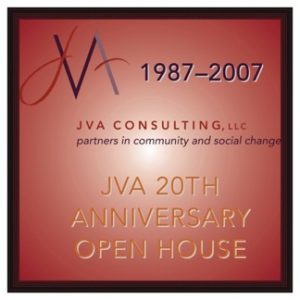
Flyer for JVA’s 20-year anniversary event
Bilingual Evaluation and Research Associate Silvia Solis: Legacy in relation to JVA to me refers to the long history during which JVA has existed in and worked with the Denver and Colorado community. I think this has created a solid foundation and proven track record upon which great work can be done.
The known brand name across various circles and networks of influence help open doors for new relationships to be built. I think it also is a great area of opportunity to experiment with new ways of doing things that push the envelope on equity and create true change in the areas of DEI.
I think everyone at JVA, an interdisciplinary team, brings varied perspectives and viewpoints that help contribute to a whole that is multifaceted and responsive.
Director of Strategic Planning and Communications Nora Welch: I think of legacy as leaving something behind. In the case of JVA, what has been and continues to be left behind is a legacy of valuing learning, supporting others and commitment to positive social change.
Nora: “The whole ‘friend and champion’ thing isn’t just a catchy slogan, it’s descriptive of the ongoing approach of our company … and it’s incredible to me how that vibe continues through the decades, to the benefit of our clients and our team.”
Intern Sarah Martinez: Legacy to me means that the work you are doing makes a memorable impact.
I found the internship opportunity at JVA through an organization that has a working relationship with JVA’s grantwriters. They spoke so highly of JVA and their approach to the field that I decided to go for it!
JVA has left their mark through the work they do. I am happy to be part of the team and learning from everyone here.
Senior Resource Development Associate Lisa Cirincione: JVA was founded as a grantwriting firm, and we have added new services, but grantwriting has remained a core service throughout its 33-year history.
Over that time, the company has grown well beyond our founder’s kitchen table. Our office has changed four times, and with each change we’ve been circling Sloan’s Lake in a counter-clockwise direction. One more office and we will have come full circle.
2. How have JVA’s partners/clients been part of our legacy? And/or how do you see diversity, equity and inclusion as part of JVA’s legacy?
Jill: It may be cliché, but it’s true: Our partners and clients are as much a part of our legacy as anything else—we wouldn’t be where we are without the opportunities to learn from and engage with the range of organizations we’ve had the honor of supporting since our inception.
It’s directly because of our partners/clients and their communities that we’ve also had the opportunity to continuously evolve and enhance our own thinking and understanding of what DEI means and how it shows up in all our collective work and spaces.
Jill: “I’m grateful that at its core, JVA’s legacy is learning and leaning into growth … as individuals, as an organization and alongside changemakers.”
Lisa: I think Clínica Tepeyac was one of JVA’s original clients. Family Star Montessori was too, and that is Latina-led and designed to serve low-income, Spanish-speaking children.
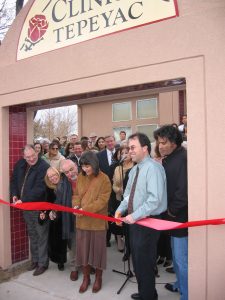
Clínica Tepeyac’s ribbon cutting on its new site in 2006
Denver Public Schools was the first client. JVA has always worked with clients who are community-led, which usually involves being mostly female staffed and, often, led by people of color.
Nora: Simply put, we wouldn’t have a legacy if it weren’t for our clients and partners.
From our decades-long relationships to one-time engagements, the people we work with not only sustain our business, but enhance and grow it. Our clients and partners share hands-on learning and lived experiences that help us deepen our understanding, sharpen our tools and innovate new ways to contribute.
They also provide honest feedback when things go well and when things don’t, ask important and challenging questions, introduce us to new thoughts or opportunities, and so much more.
We demand more of ourselves because our clients and partners deserve the best—in turn, this has created a 33-year history of excellence, fueled by our core commitment to positive social change.
3. How do you think JVA’s long history affects your work or your approach to your work here?
Nora: JVA has completely up-leveled the way I think about social issues, approach problems, identify solutions and create deliverables. Not only have I learned a ton from “all who have gone before me,” but I also recognize the honor of being a part of this lineage.
I am very motivated by doing right by our clients and communities and doing my part to uphold the legacy of the good work by my current and former colleagues.
Research and Evaluation Associate Aaron Schonhoff: I often get to work with clients who have been working with JVA for longer than the 4+ years I have been here. I know many have said they have come back because they liked the work JVA did for them; our approach and our thoroughness.
This affects my work because I know any prior work that has been done was done to a certain level, and that is always a bar I need to make sure I meet to the best of my ability.
Director of Grants Erin Shaver: I worked at JVA in 2007–08, right around the first economic crash/2008 election year. I came back to JVA right before Trump was elected in 2016.
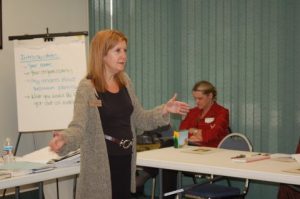
Janine Vanderburg facilitates at JVA in 2007
I have worked at JVA during two elections, three presidents and several economic booms and busts, so far, and seen how the changing priorities and federal climate (as well as economic climate) impacts our clients and our work. It’s been an interesting evolution to be a part of all these different chapters.
I also have seen JVA from when Janine (our founder) was still at the center of the everyday and every decision, and worked with her closely on many things, and we also experienced the life cycle of her leaving the day-to-day.
I know many nonprofits go through this when their founders move on, and it’s been helpful to go through this as an organization as well— I think it helps us relate to our clients who experience this, which is so common in the sector but also can be a very challenging chapter.
Lisa: In all these years, we’ve really honed our grantwriting practice, and are the most successful firm in the Intermountain West. Since our 1987 founding, we’ve helped our grantwriting clients raise over $1 billion.
Senior Grantwriter Katalin (Kat) Wishart: Because JVA has such a long history of grantwriting, we have a really solid process for writing high-quality grants. Each grant is reviewed by another grantwriter and an editor before we send a draft to the client.
With three sets of eyes on each grant, we make sure we thoroughly and clearly answer funders’ questions.
4. Is there some institutional knowledge you feel you have access to, working at JVA?
Nora: Holy moly, yes. In a very literal sense, we have a MASSIVE amount of information (studies, systems, reports, trainings, etc.) collected on our server—doing a deep dive there can feel like an Olympic-level event!

Janine dressed up for Halloween 2006
Even more so, I think what’s exciting is seeing the evolution of these documents, ideas, strategies, etc. over time. Even over the last five years, I’ve watched us build on what we’ve done before to reach new heights of understanding and execution.
As an employee of JVA today, I have the benefit of learning from what’s been done in the past, paired with the flexibility (and directive!) to find new, better ways of doing things for the future.
Copyeditor and Writer Sandy Wiegand: I think I first truly grasped the extent of JVA’s institutional knowledge when I attended an internal training session on strategic planning, led by Janine. I have some familiarity with the tools JVA’s facilitators use, but at that training I realized that they are evidence-informed practices distilled from dozens of books and research that Janine, Jill and the team have read and assessed over many years.
Sandy: “You can’t pick up a single source and learn what JVA does. And each element has a purpose.”
For example, I had an “aha moment” when I connected JVA’s Ubuntu card icebreaker activity to the emphasis in our Achieving Your Goals white paper on engaging the appropriate identity when goal-setting. JVA’s approaches really are based on research and solid science, and I think that sets us apart and is an important part of our legacy.

Jill and former JVAer Christy Bergman at a Women’s Foundation of Colorado event in 2017
Jill: Because of that 33-year history, we all have access to an incredibly strong foundation of experiences and perspectives gained from working with all different client types at all different life stages with a diversity of goals and areas of focus—this means we can apply unique lessons and evolved approaches to those we have the opportunity to support today.
Lisa: It has been my privilege to work for JVA for almost 20 years, and I am proud that some of our clients have been with us since the beginning.
I think it’s pretty safe to say that we’ve tried to offer services that are accessible to all nonprofit organizations from trainings to turn-key grantwriting services.
Kat: Lisa and Erin have both been with JVA for over a decade, so I definitely benefit from being on the grants team with them. They both have an incredible amount of institutional knowledge and were here to support nonprofits during our last economic crisis in 2008.
Sarah: It amazes me the memory JVA staff has of past projects and the diverse organizations across Colorado. Anytime I have a question about an organization, they have an answer. To me it shows how meaningful the work is to the staff and how they value Colorado’s changemakers.
5. Can you think of a lesson you have learned from a previous crisis or challenge that has helped you to be prepared in some way for the challenges JVA’s clients and partners are facing as a result of COVID-19?
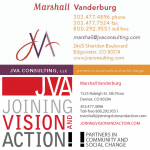
Marshall’s business cards, past and present
Marshall: The most relevant lesson JVA learned from a similar crisis to COVID-19 was the fallout from the great recession. Much of JVA’s client base had to rethink and retool services based on their constituency needs driven by the diminishment of certain crucial industries, promoting high unemployment, lower wages and lack of resources.
JVA had to learn and work with clients to think through and plan for the services and resources needed to weather the recession.
While the impact COVID-19 is economically similar for many populations, its effect is much more fundamental in changing how we relate as a network of individuals and as a society.
Marshall: “Our clients serve various constituencies, many in need of resources, human services, jobs, food, access to education and a better quality of life. How these services are provided within the COVID-19 context and the legacy that leaves post-COVID-19 is the challenge we must plan for and assist our clients with.”
Lisa: Whenever I start to freak out about how long this pandemic will hurt nonprofits, I remind myself that we’ve been through a deep recession before that caused a lot of economic fallout, but foundations rose to the occasion and kept funding critical work, even when sequestering brought limits to discretionary federal grant programs.
The 2008 recession also ushered in a wave of new grant opportunities to help people upskill so they would be work-ready for those industries that were having a hard time finding knowledgeable and trained employees. That helps me remember that there will be silver linings that come out of the pain caused by COVID-19.
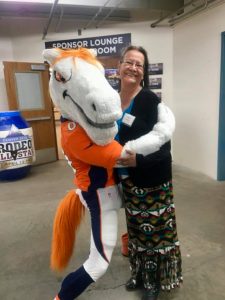
JVA Office Manager and Training Coordinator Stella Carrasco at an event circa 2017
Kat: People really rely on certainty, and we are all trying to make sense of the various crises that are unfolding every day. But nonprofits operate under uncertainty all the time.
Nonprofits exist to provide essential services to people who cannot afford to pay for them. Our clients always work with the uncertainty of where and how they will secure the funding necessary to help the people they serve.
And the more they help, the more need they uncover, so then the question becomes: How can they help even more, and how will they cover ever-increasing costs? Their ability to operate under uncertainty all the time makes them especially well equipped to innovate and survive in times of crisis.
Nora: I will always remember a practice a previous supervisor shared—she told me about taking the “curious approach.”
Instead of making any assumptions or decisions about something (especially when things are challenging or going sideways), think about—and ask questions around—what you don’t know, what you could be missing, what new opportunities might be possible, what perspective isn’t being represented, what seemingly unrelated components could be at play (e.g., someone’s dog went missing or a child got sent home from school, affecting his or her emotional and relational health), and so many other factors that can play out when you work with people.
I think this frame of reference is particularly helpful for having conversations during challenging times.
Sarah: I started interning at JVA just a few weeks before COVID-19 hit and we went into quarantine. I appreciated how JVA worked to prepare and get ahead of the problem.
They not only made attempts to adapt and prepare for the team, but also supported the community and our partners. The way they responded to the crisis is something I will carry with me in my career and use as I work in leadership roles.
JVA’s commitment to innovation and to equity, along with our 33-year legacy, are what differentiates us from other consultants that serve changemakers. Learn more about our mission, vision and core values on our About JVA page, and in our blogs.







Leave A Comment